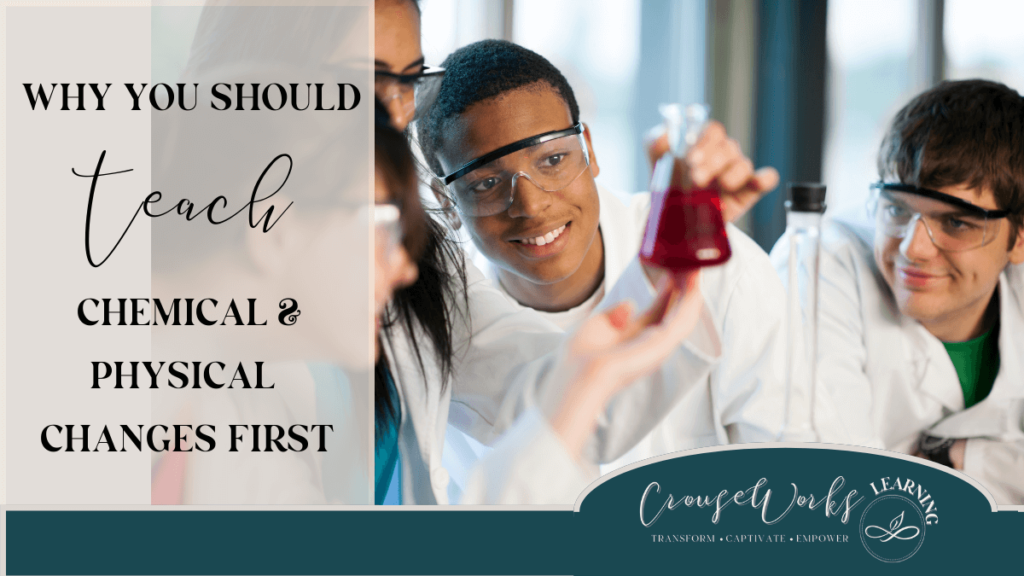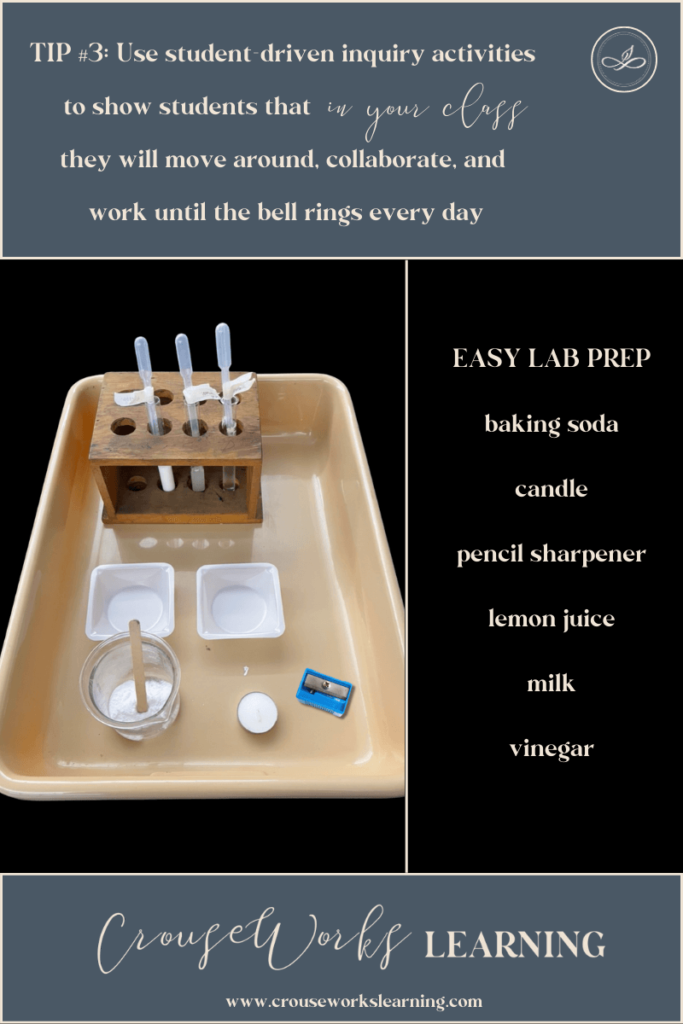From the title of this article, you might be wondering why I start the school year with a lesson on physical and chemical changes and properties rather than the metric system, lab equipment, and the scientific method.
Does it pique your interest even more to learn that I also use this lesson on physical and chemical changes and properties in place of start-of-the-year culture-building activities?
If you’re curious as to why I’m such a big fan of teaching chemical versus physical changes right at the start of the year, read below to find out more!
Why I used to struggle at the start of the year...
As teachers, we know the importance of connecting with our students at the start of the year. We’ve all heard the suggestions to “build relationships with your kids” and “incorporate more culture-building activities in your classroom.” And while I wholeheartedly agree that relationship-building is a priority at the start of the school year, in practicality, it can be more challenging than it looks.
I don’t know about you, but my personality, at times, can be a bit reserved and more introverted. So truthfully, the thought of leading whole-class culture-building activities in August has always felt… exhausting to me… not to mention intimidating…
It may surprise people to learn that teachers are not always comfortable standing in front of a room full of teenagers, facilitating meaningful whole-class discussions about life and other relatable teenage topics. And yes, while that is a part of our job, at least sometimes, it is not a skill that comes naturally for all teachers.

What I've learned after years in the classroom...
This is my 10th year in the classroom, and I’ll be the first to admit that my culture-building activities have evolved quite a bit since I started teaching.
When I was in my first few years of teaching, I remember trying everything. I went all in during the first weeks of the school year to build culture and connect with students. During those early years, I would have students take “get-to-know-you” surveys and personality/ strength tests. I would have students set S.M.A.R.T. goals for themselves. I would challenge students to collaborate in teams, surviving plane crash scenarios and crossing invisible rivers of lava in my classroom. One time I even started out the school year performing my very own motivational TedTalk for kids- talk about the prep work for that one! So yes, you name it, and I’ve likely tried the culture-building tactic in my classroom!
But, now, 10 years into teaching, do I still bust out all the bells and whistles that first week of school? Do I still go out of my way to put a big show on for students? Or do acrobatics as I try to create meaningful, team-building activities that are not cheesy for teenagers?
Mmmmm… not quite… If there is anything I have learned about being a teacher, you must make systems and routines work for you if you want to make this job sustainable in the long run. If the routines in your classroom don’t work naturally for your personality, you won’t be able to keep them up.
How I start my year now instead...
So, what has been my compromise, then? How, as a chemistry teacher, have I been able to focus on chemistry content at the beginning of the year while still creating a welcoming classroom environment, inspiring community among students, and fostering respect between myself and students? In other words, how have I been able to still get students bought into my chemistry class without having to put on a big show at the beginning of the year?

If I've piqued your curiosity, read below to see the three reasons why I teach physical and chemical changes and properties first thing in the school year!
REASON #1: How a lesson on physical versus chemical changes tells students all they need to know about your class
All students have seen bread go into a toaster and come out charred. They have all likely had their hair cut at one time. Physical and chemical changes are a normal part of everyday life. Everyone recognizes the difference between a bike that lost a wheel and a rusted bike that was left out in the rain. And even when you stand in front of the room and tear a piece of paper in front of students and light another piece of paper on fire (temporarily), students will quickly tell you which was the chemical change versus the physical change. Students can’t often explain the chemistry behind why they know what they know. Still, they know it when they see it.
Students will feel more comfortable and safe participating in chemistry when you intentionally start the year with a simple yet relatable topic, such as physical and chemical changes and properties.
Think of it this way. The beginning of the school year is your unique chance to form a first impression with your students. From the second students walk in the door on that first day in August, they are continually analyzing the environment of your classroom. Is this class going to be easy or difficult? Interesting or boring? What kind of teacher will you be? Can they expect to feel comfortable and safe in your classroom? To what expectations will you hold them? With all these questions swirling around their heads, why not give students some answers?

It really is that simple...
For years I used to overcomplicate the culture-building process. I ran myself ragged trying to come up with engaging, non-cheesy whole-class activities to do at the start of each year. And while those culture-building tactics work for many teachers, over time, I became exhausted. And, even worse, I started dreading when August rolled around each year and I had to get my “performer” hat back out.
What I didn’t realize though, is that my students didn’t need me to do all that. That truthfully, what they sought most on that first day of school was simply for me, as the teacher, to calm their nerves. If I let them know what they could expect from my class, that alone was the security they needed to trust me and move forward with the school year.
Make it a priority to reference students' background knowledge
At the start of the school year, most chemistry teachers (including myself) typically jump into content lessons on the metric system, lab equipment, and the scientific method. However, one year, when I decided to skip all of that and instead start with a lesson on physical versus chemical change, I noticed something interesting… Students began stepping up as leaders in the classroom (at the start of the year!). Additionally, more students were willing to chime in about their background experiences during class discussions. And because it was such a simple topic, I saw students actively checking in with each other and tutoring one another through the practice problems.
Suppose students begin the year by participating at this level. In that case, it solidifies for them the message, “In this class, I work hard and can contribute. In this class, I have knowledge that is helpful.” And isn’t that the fundamental goal of culture-building? To instill in students a sense that not only do they belong, but they are also assets in the classroom.

Sometimes, as teachers, we get lost in the nuances of culture and relationship-building. It becomes its own entity rather than simply being a tool to help you and your students. If you can establish a classroom where students feel welcomed, feel comfortable contributing their background knowledge, and recognize your high expectations of them, you have successfully built a culture in your classroom!
I say this because, if you are like me, and the start of the year feels too much sometimes, please know you have permission to not put on a show for your classes. You have permission to take your “performer” hat off and to instead start the year with routines that work best for your personality!
Use student-driven inquiry work to challenge students
I like to leverage students’ background knowledge at the beginning of the year by having students look at pictures and come up with their own definitions for physical versus chemical change. This immediately puts students in the driver’s seat. Rather than defining for students what a chemical versus physical change is and what four signs indicate a chemical change has occurred, I put them in charge. I want to see if they can explain a chemical change and how they know if it has occurred.
If you challenge students with student-driven inquiry work from the start of the year, you solidify for students the message that, “In this class, I am capable of leading my own learning. In this class, I do not need to rely on the teacher.” And this again, accomplishes the goal of establishing a strong classroom culture!
Build students up for easy wins later in the school year
One of the greatest benefits of starting the year with a lesson on physical versus chemical change is that you set students up for easy wins throughout the rest of the school year. When students know the difference between a chemical versus physical change, they will apply this knowledge more readily throughout the school year. All labs in chemistry entail some physical or chemical change. Whether it’s fizzing bubbles, a color change, the formation of heat and light, or a precipitate, students can identify the indicators of a chemical change for the rest of the year. This makes for easy wins later on when you need to call on students to answer questions. For the rest of the school year, you can call on any student in your class, and they will be able to tell you that a color change means a chemical reaction has occurred.
REASON #2: How a lesson on physical and chemical changes and properties helps students see your class's relevance
One of the activities I like to start the lesson with is showing students an article on the carcinogenic effects of charring marshmallows (click here).
I ask students, “Should we care if marshmallows are more carcinogenic after burning them? Aren’t marshmallows just made from sugar, after all?”
This really gets students going…
“Yes, marshmallows are different after they’ve been burned!” a student will say.
“How do you know the marshmallows are different?” I’ll ask.
“They have a black color after being burned,” another student responds.
“Okay, so what does that signify then?” I’ll ask.
“I don’t know. All I know is that they are different,” the same student responds.
Again, as with many things in chemistry, students can’t often explain the chemistry behind why they know what they know. Still, they recognize it when they see it. And this kind of article gets into a good discussion as to whether a substance can be chemically altered into something else and why it matters.
At the end of the lesson, I have students return to this same question and perform a claim-evidence-reasoning for whether or not they should care if marshmallows are chemically changed after being burned.
Starting the year with physical and chemical changes and properties means I can make easy connections to students’ everyday lives, particularly to topics that interest them. And this solidifies for students the message that, “In this class, I learn things that matter. In this class, my time is used wisely and the knowledge I gain helps me to better navigate the world.” Now, if there is any takeaway you want students to have from their first week of school, isn’t that the takeaway you hope they walk away with?!
REASON #3: How a lesson on physical and chemical changes and properties gets students used to working until the bell
In my classroom, I want students to be active. I want them to know they will have to move around, collaborate, and work until the bell rings every day. That is why I like this lesson on physical versus chemical change. It allows me to incorporate two simple labs during that first week of instruction. I know what you are thinking, “Two labs! That’s a lot of setups!” Hear me out. It really isn’t.
- In the first lab, students analyze common everyday phenomena to determine if a chemical change has occurred (e.g., a candle is lit, sharpening a pencil).
- The second lab involves students using their knowledge of physical and chemical changes and properties to distinguish between 5 unknown white powders (baking soda, salt, cornstarch, etc.). They perform simple tests like, “Does the powder react with vinegar (demonstrating the property of acidity)? Or does it dissolve in water (demonstrating the property of solubility)?” From these tests, they can then narrow down which powder is which. This second lab is especially significant because it also ties into forensic chemistry and how crime scene investigators identify unknown powders.
I like to jam-pack my lessons at the start of the year with these two easy-to-set-up labs because it solidifies for students the message that, “In this class, I work hard. In this class, we use every minute wisely.” And yet again, this accomplishes the goal of building a strong classroom culture that will carry you through the rest of the year!
To wrap things up...
I know how tough the start of the school year can be. Students don’t realize that, as teachers, we are just as nervous as they are! As teachers, we also struggle with social anxiety and feel torn between needing to perform and just wanting to be ourselves. But, if there is anything I have learned about being a teacher, you must make systems work to keep this job sustainable. You have to be yourself as a science teacher and do what feels comfortable for you. I hope this article has given you some helpful ideas on how to build culture in your classroom in ways that are organic, sustainable, and fun for you!

Excited to try teaching physical and chemical changes and properties, but still trying to figure out how to go about it?
Check out this resource which includes:
- 2 Easy-to-set-up labs
- Student-led inquiry investigation
- Text analysis
- Application problems
Looking for more tips and tricks on how to get students motivated at the start of the school year in chemistry?
Check out this beginning-of-the-year NGSS phenomenon-based unit on wildfires!





